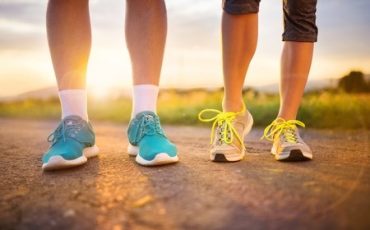In walking you don’t dress from head to toe, you dress from toe to head. Think of it this way: The snazziest, most finely tuned sports car on the road won’t perform as it should without a solid set of appropriate, high-performance tires. Your body, too, won’t be able to reach its full walking potential without a great pair of high-performance shoes. You see, walking isn’t just slow running. Biomechanically, the body moves differently when it walks than when it runs, placing stresses in different places, in different ways, and at various degrees. Your body even moves slightly differently when you walk quickly compared to when you walk slowly. Simply put, walkers require a walking shoe. Brisk and athletic walkers require an athletic walking shoe.
 Look for the following qualities in a walking-specific shoe:
Look for the following qualities in a walking-specific shoe:
- Good heel cushioning. Walkers strike the ground hardest on the heel rather than on the middle or front part of the foot, as most runners do. This heel strike leaves you for a nanosecond in a slightly precarious tippy position balanced on your heel, therefore demanding more heel stability in a shoe.
- Flexible forefoot. A walker’s forefoot flexes at nearly twice the angle of a runner’s at toe push-off, which requires more flexibility in the front of the shoe.
- Roomy toe box. The powerful push-off causes the toes to spread significantly, and the heel plant may cause the toes to lift more into the angle. These actions require a roomy, tall, and wide toe box, or front of the shoe.
- Supportive heel construction and a low profile. The higher, sometimes slightly flared heel typical of running shoes makes a walker less stable and acts as a fulcrum, causing the foot to slap down harder. That overworks the shin muscles, which can produce shin and ankle pain. A shoe with a lower profile, or lower heel, is more appropriate for walking.
- Minimal underfoot cushioning and lateral support. When walking, the impact on landing is about a third (or less) that of running. Walkers also only move in a linear, forward motion, so the emphasis on lateral support in shoes for racket sports, aerobics, or trail running is not useful.
Faster walkers, as well as those living in hotter climates or simply pre- disposed to hot feet, benefit from breathable mesh uppers so that a hot foot can cool quickly and sweat can evaporate during and after a walk.
You can easily drop as much as $120 on a high-end pair of walking shoes, but you can also get a good pair for $50 or $60. Any cheaper than that (unless it’s a great closeout deal) and the shoe probably only looks the part and will break down or cause injury. Some fitness and general interest magazines publish annual surveys of walking shoes, but don’t take a rating as gospel because you never know if the advertising department influenced the outcome. You might get recommendations from a friend or colleague too, but your movement,
support, and cushioning needs may be different. Over the last several decades, the number of and variety in walking shoes have increased greatly, but that also means you may become utterly baffled by the choices.
Start your search for the perfect walking shoe on the Internet. Go to major shoe manufacturers’ Web sites and read about their shoes. This will help you pare your long list to a few based on those descriptions. If you stumble across a shoe review on an unknown site, question it and the source. It might be legit, but you don’t know that (anybody can slap something up on the Web and call himself or herself an expert).
Next, go to a specialty athletic footwear store and try on all the name brands, even those you may have picked out on the Web sites you visited. A good store will let you take a quick jaunt down the sidewalk or hall, and its staff will even watch you move to see if the shoe is right for you. I am not against large sporting goods stores, but in some cases you receive less help, less-informed help, and sometimes even old models. Be warned, if you have made it clear you’re a walker, do not listen to or buy from a sales person who tells you that you should buy a running shoe. Go to a different store. The sales clerk is either uninformed or a running snob. (Exception: If you plan to walk and run, you are better off with a flexible, low-profile running shoe so that you also get enough cushioning for that higher-impact activity of running.)
If you still haven’t found what you want or a specific shoe you saw on the Web, ask about special orders. Many stores will do this and might not even require a deposit or a guarantee you’ll buy (be sure to ask so that you aren’t surprised). You can also contact the manufacturer directly if you can’t find the model you liked or the size or width you need; manufacturers can often recommend you to retailers they work with or to online retailers who carry a full virtual warehouse with a broader selection. Some manufacturer Web sites include searchable directories of their retailers.
What about aesthetics? Walking shoes used to look like nursing shoes—all white, all leather or synthetic, and really boring and grandmotherly looking. No more! Today’s walking shoes can have as much flash, style, and color as you want. Have fun with that.
If you plan to do many workouts on trails or hills with loose or uneven terrain or rocks, consider those needs. Look for better grip and stability and even a light hiker, or what some companies call brown walkers or country walkers—walk- ing shoes that look a little like a hiking shoe. They are still lightweight, but usually come in darker colors. Features might include a higher top for ankle support (only good if you plan to do more hiking), deeper tread and stickier outsole for nonslip walking over dirt and rocks, better lateral stability, and a higher heel to ease Achilles tendon tension while you’re walking uphill. Some may also be made of Gore-Tex or other waterproof or water-resistant materials for rainy or wet outings.
If you’re interested in race walking, you need special shoes designed for the sport’s high speeds that exaggerate basic walking technique. They have much flatter soles to better skim the ground and to accommodate the increased ankle flexion upon heel strike, plus they have slipperlike forefoot flexibility. There are a few race-walking shoes on the market, but many people end up in basic lightweight running shoes.
Your shoes might look great from the outside for years, but the insides lose about a third of their ability to support and absorb shock after 500 to 600 miles. For example, an average walker—someone putting in 3 miles three or four times a week—needs replacement shoes after about a year. Walk more and you need new ones more often.
Shoes should be able to go from store shelf to work out without a hitch. Still, a new pair of shoes might pinch in a different place or cause you to land differently than you’re accustomed to. Just the fact that the materials in your new pair aren’t broken down causes them to fit your feet differently. Try out new shoes on short or easy workouts to make sure they don’t cause soreness, blisters, or strain.
Be continually aware of how your feet and body feel. More experienced walkers know a shoe is ready to trade in when they get a particular ache in the ankles or hips. Watch the tread to see where it’s wearing out, and compare the soles of both shoes to each other. Are they permanently tilted one way or the other (perhaps one more than the other) when you put them on a table and look at them from behind? Does one foot have more wear than another? That test will give you an idea of where your gait may be uneven.
The wear pattern on the bottom of your worn-out shoes might be an indication of needless pain on the horizon. Shoes aren’t the place to be chintzy. Retire the old ones to shopping trips or gardening, and keep your good walking shoes just for fitness walking so that they last longer.
Few people have perfect feet. Most either supinate (roll outward) or, more commonly, pronate (roll inward). High or low arches might also demand extra attention. If you are plagued by injury, a foot malfunction might be the problem. You may just need a different shoe, one with more support or cushioning. Drug- and sports stores sell a range of heel cushions, arch supports, and other inserts you can try. Podiatrists can also analyze and measure your feet for personal orthotics, if needed.
A few tips will help your investment last as long as possible:
- Don’t put shoes by a heat source to dry because that will crack and weaken the materials.
- Remove the insoles after each walk so they can dry more easily. If you have two pairs (a good idea, by the way), alternate using them so that each can fully dry between wearings.
- If your shoes get particularly wet or sweaty, stuff them with wads of news- paper or bags of cedar shavings after working out. Both help shoes keep their shape and soak up moisture and salts from sweat that break down materials.

Leave a Reply